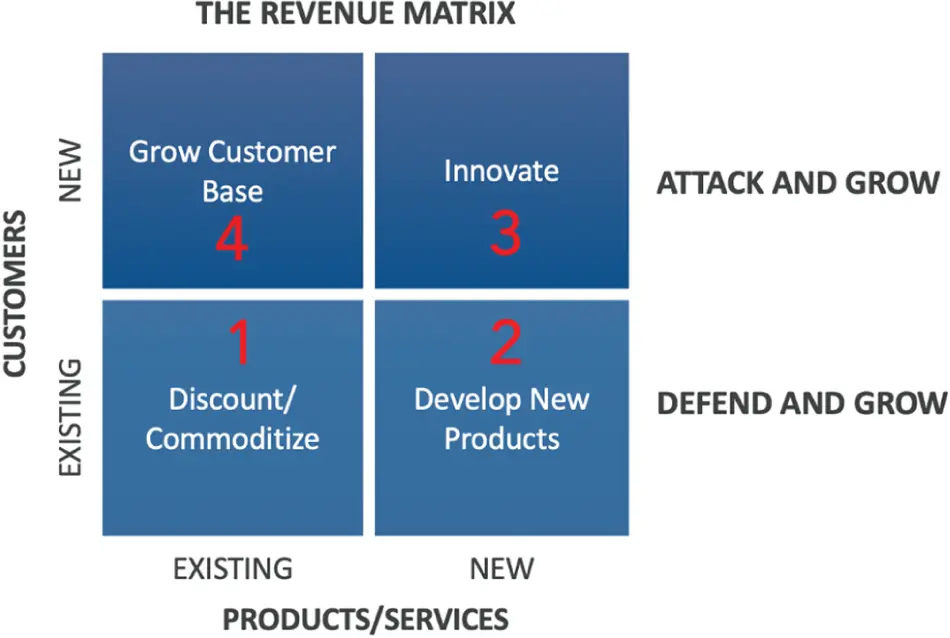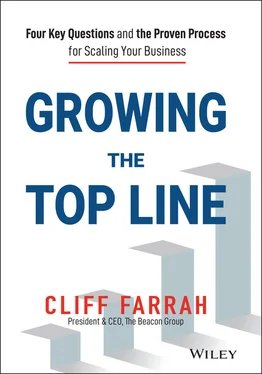All Customers Are Not Equal
Every business has preferred customers. Starbucks has their regular early morning work crowd, and they also happen to serve any out‐of‐town tourists who strolled in that day. Amazon has major named accounts that spend billions with their Amazon Web Services (AWS) business, and they have Cliff Farrah, who spends a whole bunch during the holidays, but is otherwise pretty much a non‐event to their business. All customers are not equal. As a strategist it’s important to understand and grow the best sources of our revenue and make sure we are focused on them.
Customers Buy Differently
Not every customer acquires in the same way. Some pay cash, others use credit. Some want to own, some want to rent. Some pay by the month, some pay by the drink. As strategists, we have to make it easy for all our different customers to provide us with revenue.
Now let’s shift to the second question: What do the customers buy?
If all money flows from customers, what they buy is driven by the goods and services that you offer. There are some great books about how to market and sell goods and services, and the experts we’ve interviewed throughout this book will give you real insight into best practices to maximize growth, but before we go swim in the deep end, I’d like to make sure we are aligned on some basic thoughts about goods and services and why they are procured.
Some goods and services fill a market need; many fill a want.
Goods and services are definable, measurable offerings.
They are things that can be valued.
Some Goods and Services Fill a Market Need: Many Fill a Want
As a formally trained economist, I still think in terms of utility and supply and demand. These principles are based on having something of value that is sought in the market. There are lots of ways that products are created, and we talk about a number of examples later in the book, but at the end of the day, we buy things that we need (food, water, shelter, clothing), and things that we want, but don’t really need. Sometimes it’s a want that is strong enough to make them frivolously spend money. Let’s face it, the latest AirPods Pro aren’t a need, but nutritious food is. We don’t have to have ice cream cones, but we do need clean water. Wants have very different challenges in driving growth than needs. Realize what you are offering as you consider how to grow.
Goods and Services Are Definable, Measurable Offerings
In order to transact, you have to be able to bound your offering. People need to know what they are getting for what they are paying. In some markets this is pretty straightforward. You go to a shoe store and buy a pair of shoes. Definable/measurable. When you get into services, things get much harder to bound. Toss in “as a service” and you’ll find that lawyers are making a lot of money bounding definitions of what you are and are not buying, as well as your rights to any data produced by your usage. Understanding what you are selling, especially as companies move to offerings that marry product, service, and software, is really important.
I talked about this a bit with my good friend Ray Ausrotas. Ray is one of Boston’s successful trial attorneys, a twice‐published author of Lexis practice guides, and has helped me several times throughout the years as Beacon has protected much of its own proprietary and confidential information. He is smart, tireless, fierce, and yet kind and reasonable. Killer combination. I cannot recommend him highly enough should you ever need a litigator. We talked about how poorly written and defined services agreements can lead to bad outcomes:
Especially in the services world, communication and clarity defining the scope of what is going to be a continuing business relationship – where both sides understand precisely what is being delivered, and how and when – is critical. If parties structuring their interactions rush this process (or get “go fever”) at the outset, or don’t adjust when circumstances have changed, it is not unusual to see litigation occur. Many of the commercial cases I have litigated and tried over the last 20‐plus years have had poorly defined terms at their core. Of course parties can’t realistically expect to foresee and negotiate risks for every future situation they will encounter; but hard work on the front end, with each side specifying and adequately protecting their rights (including over who holds rights to proprietary business confidential information and intellectual property), can help to prevent costly and unpredictable outcomes down the road.
He’s right. In the services world, or in the product world, what you sell needs to be clearly understood and defined. There are too many snakes out there who are all too willing to bite.
They Are Things That Can Be Valued
It may sound obvious, but in my world, growth often comes from new ideas that create goods and services that don’t yet exist. We work to help our clients “value,” or assign a dollar amount to, their idea. Later on we’ll talk about how different companies approach this, but if you want to sell something, the market has to perceive value in it. No matter how cool a new product is, or how much time you’ve invested in it, there has to be a perceived value proposition that is well understood by the client.
Combine these two most important factors and you create the revenue matrix.
When customers and goods/services collide, four sources of growth result:
1 An existing client and an existing product
2 An existing client and a new product/service
3 A new client and a new product/service
4 A new client and an existing product/service

FIGURE 1.1The Revenue Matrix
If you put them together in a two‐by‐two table, you get the Revenue Matrix that presents these categories visually ( Figure 1.1).
This is an extremely powerful way to think about the sources of revenue, and you can easily use this matrix to segment your current portfolio and growth plan. I’ve used this matrix throughout my career to consider how to drive revenue.
The first two quadrants deal with “Defend and Grow” opportunities, which are driven by existing client relationships. You want to defend them against competitors, but also grow what they spend with you over time.
Quadrant 1: Discount/Commoditize
Selling existing customers existing products and services is a staple for a sustainable business. This is where I would expect to see the vast majority of revenues come from in a business older than 1 year. Over time, in most businesses, this bucket declines due to commoditization. You get stale. You are vulnerable to a competitor’s fresher, more interesting offering.
Quadrant 2: Develop New Products
Next is the lower right‐hand quadrant, or selling existing customers new products and services. By developing or offering new products and services to existing clients, you leverage the goodwill you have already generated and are able to counter commoditization and price erosion in the prior quadrant.
The next two “top” quadrants deal with “Attack and Grow” opportunities. These are where you are acquiring a new client, typically taking them away from another vendor. Typically a heavier lift and riskier effort.
Читать дальше













